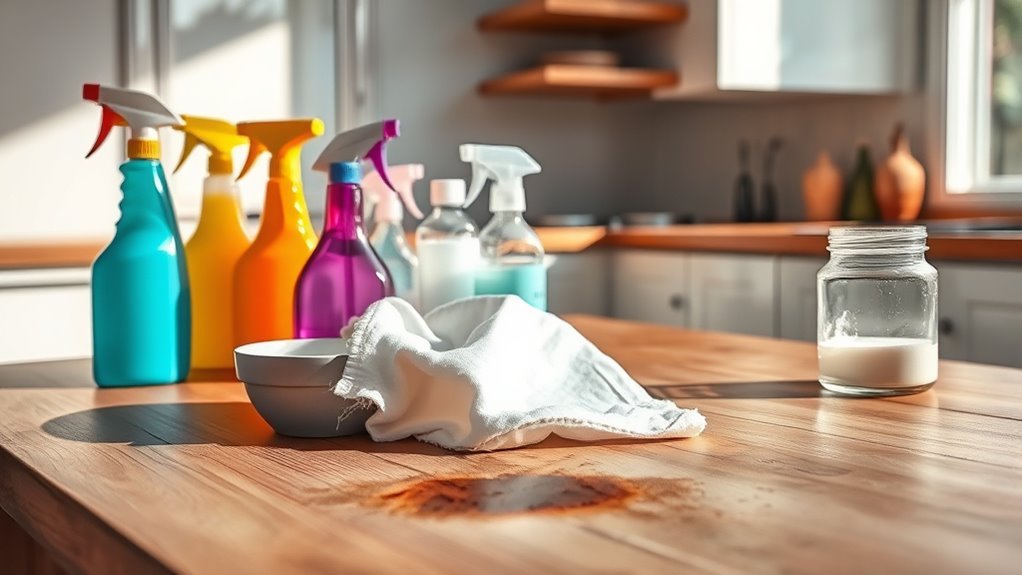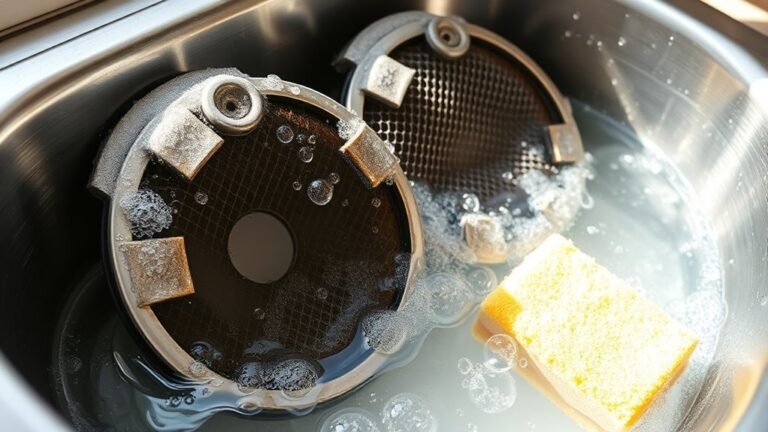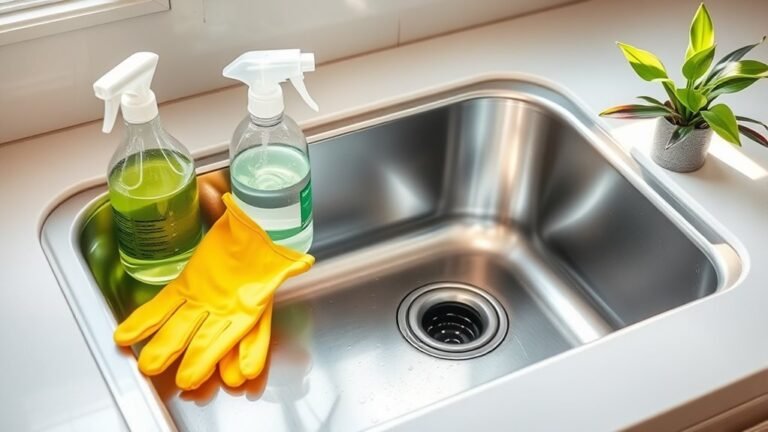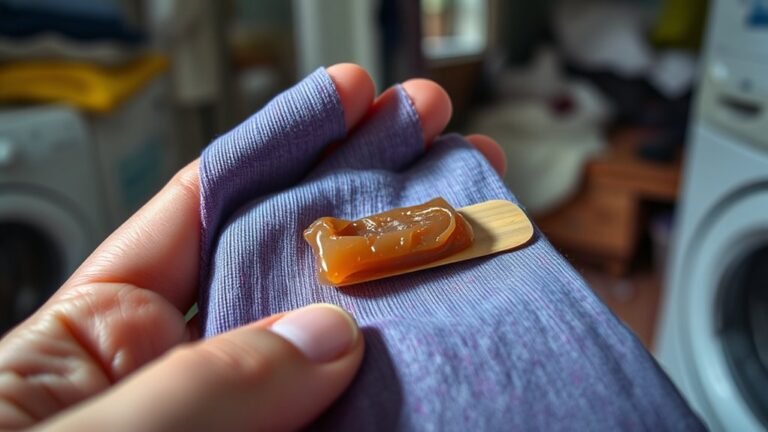Step-By-Step Guide to Cleaning Stains
To clean stains effectively, first identify the type—oil, protein-based, wine, or dirt—then gather supplies like microfiber cloths and natural agents such as vinegar or baking soda. Act quickly: blot fresh stains gently without rubbing, then apply the appropriate treatment—enzyme cleaner for protein stains or baking soda for grease. Dry mud should be brushed off before washing. Taking swift, targeted action helps prevent permanent marks and keeps fabrics fresh. There’s more to uncover for tackling tougher or unusual stains.
Identifying Different Types of Stains
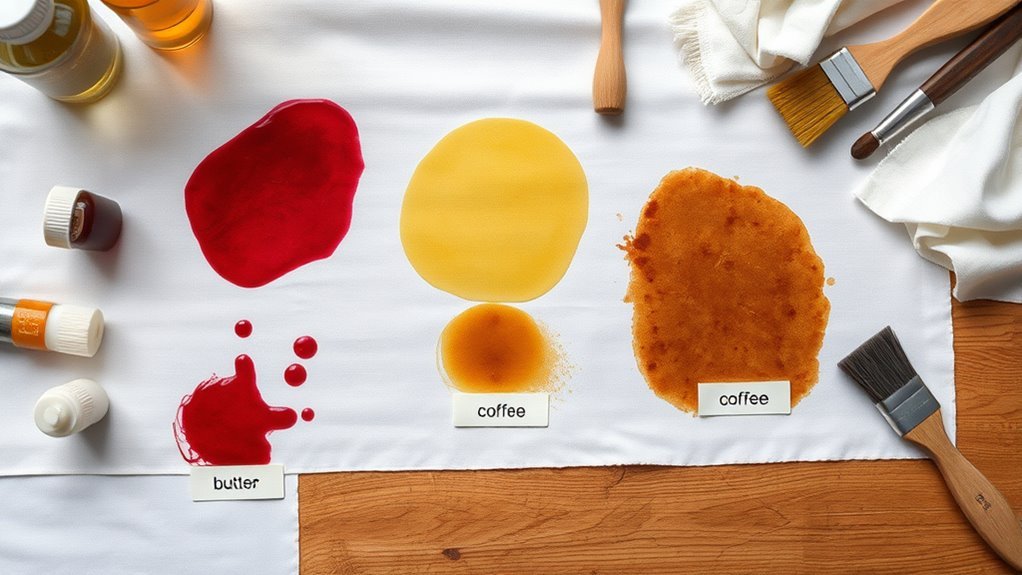
Before you can effectively clean a stain, you need to identify what type it is. Understanding stain characteristics helps you choose the right approach without wasting time or resources. Stain types vary widely—from oily spots to protein-based marks like blood or grass. Each has its own traits: oily stains feel greasy, while protein stains often have a crusty residue. You’ll also encounter tannin stains from coffee or wine, which may darken over time if untreated. Recognizing these features lets you act confidently, freeing you from trial-and-error cleaning. When you know what you’re dealing with, you gain control over the process and avoid damage. Identifying stain types is the first step toward reclaiming your space and maintaining the freedom to enjoy a clean, fresh environment.
Preparing Your Cleaning Supplies
Before tackling any stain, you’ll want to gather the essential cleaning tools and pick the right cleaning agents for the job. Having everything organized and within reach will save you time and frustration. Let’s explore what supplies you’ll need and how to set them up efficiently.
Essential Cleaning Tools
Having the right tools on hand makes tackling stains much easier and more effective. When you’re free to clean on your own terms, having essential supplies ready lets you move quickly and confidently. Focus on grabbing the cleaning tools that give you flexibility and control over the task. Here are three essentials you shouldn’t skip:
- Microfiber cloths for gentle but thorough wiping
- A sturdy spray bottle to apply water or pre-mixed solutions precisely
- Soft-bristled brushes to reach stubborn stains without damage
These tools form the foundation of your stain-fighting arsenal, helping you stay agile without relying on harsh methods. Once you’re set up with these, you’re ready to handle most stains with ease and freedom.
Choosing Cleaning Agents
Selecting the right cleaning agents is key to effectively tackling stains without causing damage. You want products that work well but also respect your space and the planet. Opt for natural alternatives like vinegar, baking soda, or lemon juice—they’re powerful and gentle. Eco friendly options not only protect your surfaces but also reduce harmful chemical exposure, giving you freedom from harsh toxins. Avoid harsh chemicals unless absolutely necessary, as they can leave residues and harm fabrics or finishes. When picking agents, consider the stain type and surface, but prioritize safe, sustainable choices that align with your desire for a clean, healthy environment. This way, you maintain control over what you bring into your home while effectively removing stains.
Organizing Your Supplies
Once you’ve chosen your cleaning agents, it’s important to organize your supplies so you can work efficiently and avoid frustration. Good supply organization frees you up to tackle stains without scrambling for what you need. Start by creating a cleaning checklist to keep track of all materials and steps, so nothing gets overlooked. Next, gather your essentials in a portable caddy or basket—this keeps everything within reach and easy to carry from room to room. Finally, arrange your supplies logically:
- Group similar items like sprays, cloths, and brushes together
- Label containers if necessary for quick ID
- Store frequently used items at the top for fast access
This approach saves time, reduces stress, and lets you clean with freedom and confidence.
Removing Fresh Stains Quickly
Although fresh stains can be frustrating, acting quickly can make all the difference in removing them effectively. When you spot a stain, use quick action to prevent it from setting. First, gently blot the area with a clean cloth or paper towel to encourage stain absorption—avoid rubbing, as that only pushes the stain deeper. Next, apply a small amount of cold water or a suitable cleaning solution to dilute the stain. This step helps break down the stain before it bonds with the fabric. Remember, the faster you respond, the easier it is to lift the stain, freeing you from stubborn marks. Taking these immediate steps empowers you to maintain your freedom from lingering stains without hassle.
Treating Protein-Based Stains
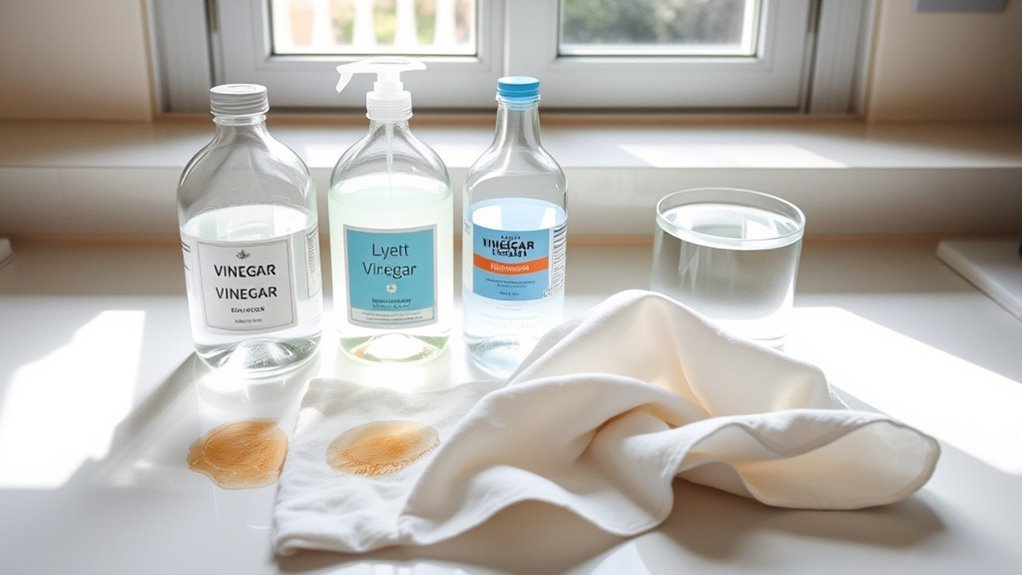
When you spot stains from things like blood, sweat, or dairy, you’re dealing with protein-based stains. Knowing how to identify these stains helps you choose the right cleaning solutions. Before washing, you’ll want to apply effective pre-treatment techniques to break down the proteins for better removal.
Identifying Protein Stains
How can you tell if a stain is protein-based? It starts with identifying sources and understanding protein types. Protein stains typically come from everyday messes, and recognizing them sets you free to tackle them effectively.
Look for these clues:
- Origin: Food like eggs, dairy, or blood are common protein sources.
- Appearance: These stains often look dull, yellowish, or crusty once dried.
- Texture: They may feel stiff or rubbery compared to other stains.
Effective Cleaning Solutions
Now that you can recognize protein stains by their source and appearance, you’re better equipped to choose the right cleaning methods. When tackling these stubborn stains, natural cleaners like enzyme-based stain removers are your best allies. They break down the proteins gently without harsh chemicals, preserving your fabric’s integrity. You can find natural stain removers at most stores or make your own using ingredients like baking soda and white vinegar. Avoid hot water initially, as it can set protein stains, making them harder to remove. Instead, start with cold water and apply your chosen natural cleaner directly to the stain. Let it sit for a few minutes, then gently blot or rinse. This approach gives you freedom from tough stains while keeping your items fresh and damage-free.
Pre-Treatment Techniques
Since protein-based stains can be stubborn, pre-treatment is key to improving your chances of complete removal. You want to tackle these stains before they set into your fabric, making stain removal easier and preserving your fabric care routine. Here’s how you can take control:
- Rinse the stain with cold water immediately to prevent it from bonding with fibers.
- Apply a gentle enzymatic cleaner that breaks down proteins without damaging your fabric.
- Let the pre-treatment sit for 10–15 minutes, giving it time to work before washing.
Tackling Oil and Grease Stains
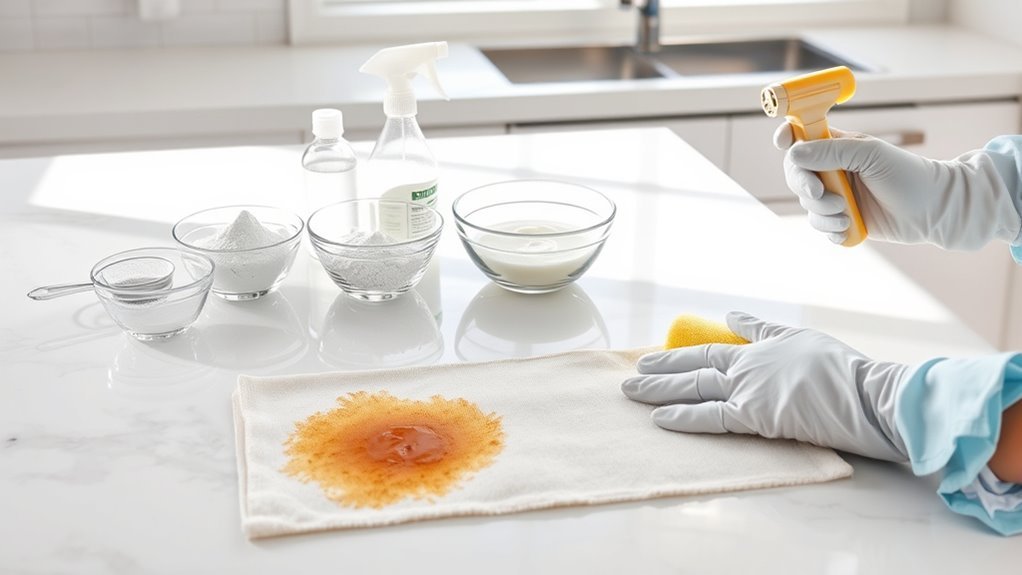
Although oil and grease stains can seem stubborn, you can remove them effectively with the right approach. Start by blotting excess oil gently—don’t rub, as that spreads the stain. Next, apply oil absorbents like baking soda or cornstarch to soak up remaining grease. Let it sit for 15-20 minutes, then brush it off. Afterward, treat the area with a powerful grease buster, such as a dish soap or a specialized stain remover designed to break down oils. Work it into the fabric, then rinse with warm water. Repeat if necessary, but avoid heat until the stain is gone, as it can set the grease permanently. With this method, you’ll reclaim your freedom from stubborn oil and grease stains quickly and effectively.
Cleaning Dye and Ink Stains
Oil and grease stains require careful handling to avoid setting them, and the same care applies when dealing with dye and ink stains. To free yourself from stubborn marks, mastering dye removal techniques is key. Start by acting quickly to prevent ink blot prevention from becoming a bigger issue. Here’s how you can tackle these stains effectively:
- Blot fresh ink with a clean cloth, avoiding rubbing to prevent spreading.
- Apply rubbing alcohol or hand sanitizer on a cotton ball to break down dye molecules.
- Rinse with cold water and launder as usual, checking the stain before drying.
Handling Wine and Coffee Stains
When you spill wine or coffee, acting fast can make all the difference in preventing a lasting stain. For wine removal techniques, grab a clean cloth and gently blot the spill—never rub, as it spreads the stain. Pour a bit of cold water on the spot to dilute the wine, then apply a mixture of dish soap and hydrogen peroxide if needed. For coffee absorption methods, quickly sprinkle salt or baking soda over the wet area to soak up the liquid. Let it sit for a few minutes before brushing it away. Then, blot with a damp cloth and use a mild detergent to clean any remaining residue. By handling these spills promptly, you keep your freedom from stubborn, permanent stains.
Dealing With Mud and Dirt Stains
Since mud and dirt stains can quickly set into fabric, you’ll want to treat them as soon as possible. Start by letting the mud dry completely—wet mud just spreads. Once dry, gently brush off the excess to avoid pushing the stain deeper. For effective mud removal, follow these steps:
Treat mud stains quickly: let mud dry, brush off excess, then tackle the stain to keep fabric fresh.
- Rinse the stained area with cold water, working from the back of the fabric.
- Apply a stain remover or liquid detergent directly to the stain, allowing it to sit for 10-15 minutes.
- Wash the garment as usual in the warmest water safe for the fabric.
Acting fast gives you the freedom to enjoy your adventures without worrying about stains. Keep your clothes fresh and embrace life’s messes without hesitation!
Tips for Preventing Future Stains
Although you can’t avoid every spill or smudge, taking simple precautions can greatly reduce the chances of stains setting in. Embracing preventive measures like using stain resistant fabrics and acting quickly when spills occur helps keep your freedom intact—no more stressing over stubborn marks.
Here’s a quick guide to keep stains at bay:
| Preventive Measure | Example | Benefit |
|---|---|---|
| Use Stain Resistant Fabrics | Outdoor cushions, workwear | Easier cleaning, less damage |
| Immediate Spill Response | Blotting spills instantly | Prevents deep penetration |
| Protective Barriers | Tablecloths, aprons | Shields surfaces and clothes |
Frequently Asked Questions
Can Stain Removal Damage Delicate Fabrics?
Yes, stain removal can damage delicate fabrics if you’re not careful. These fabrics often have lower durability, so harsh chemicals or vigorous scrubbing might weaken their fibers or cause discoloration. To protect your freedom to wear and enjoy them, focus on gentle stain prevention methods and always test cleaning products on a small, hidden area first. Taking these precautions helps keep your delicate fabrics looking great without risking damage.
How Do I Safely Clean Stains on Upholstery?
When cleaning stains on upholstery, first identify your upholstery types—like leather, microfiber, or cotton—since each needs different care. You’ll want to use gentle cleaning tools, such as soft brushes or microfiber cloths, to avoid damage. Test any cleaner on a hidden spot first, and don’t saturate the fabric. By choosing the right tools and methods, you can free your furniture from stains without risking harm, keeping your space fresh and inviting.
Are Natural Stain Removers as Effective as Chemical Ones?
Isn’t it fascinating how nature often hides powerful solutions in plain sight? When you choose natural ingredients for stain effectiveness, you’re embracing a gentler, eco-friendly approach that can rival chemicals, especially on fresh or light stains. While chemical removers might act faster on tough stains, natural options give you freedom from harsh toxins and often work well with patience. So, it’s about balancing your values with the stain’s stubbornness.
What Should I Do if a Stain Persists After Cleaning?
If a stain sticks around after your initial cleaning, don’t stress. You can try alternative stain removal techniques like soaking the fabric longer or using a different cleaning agent suited for the material. Sometimes, persistent stain solutions involve repeating the process or combining natural and chemical methods carefully. Remember, staying patient and experimenting a bit lets you reclaim your freedom from stubborn stains without damaging your favorite items.
How Often Should I Deep Clean Fabrics to Prevent Stains?
If you don’t deep clean your fabrics regularly, they’ll practically scream for help! To keep your freedom intact, aim for fabric maintenance every 3 to 6 months. This cleaning frequency stops stains from settling and keeps your clothes feeling fresh and ready for anything. Think of it as giving your fabrics a little vacation from grime, so you can enjoy life without worrying about pesky spots cramping your style.
